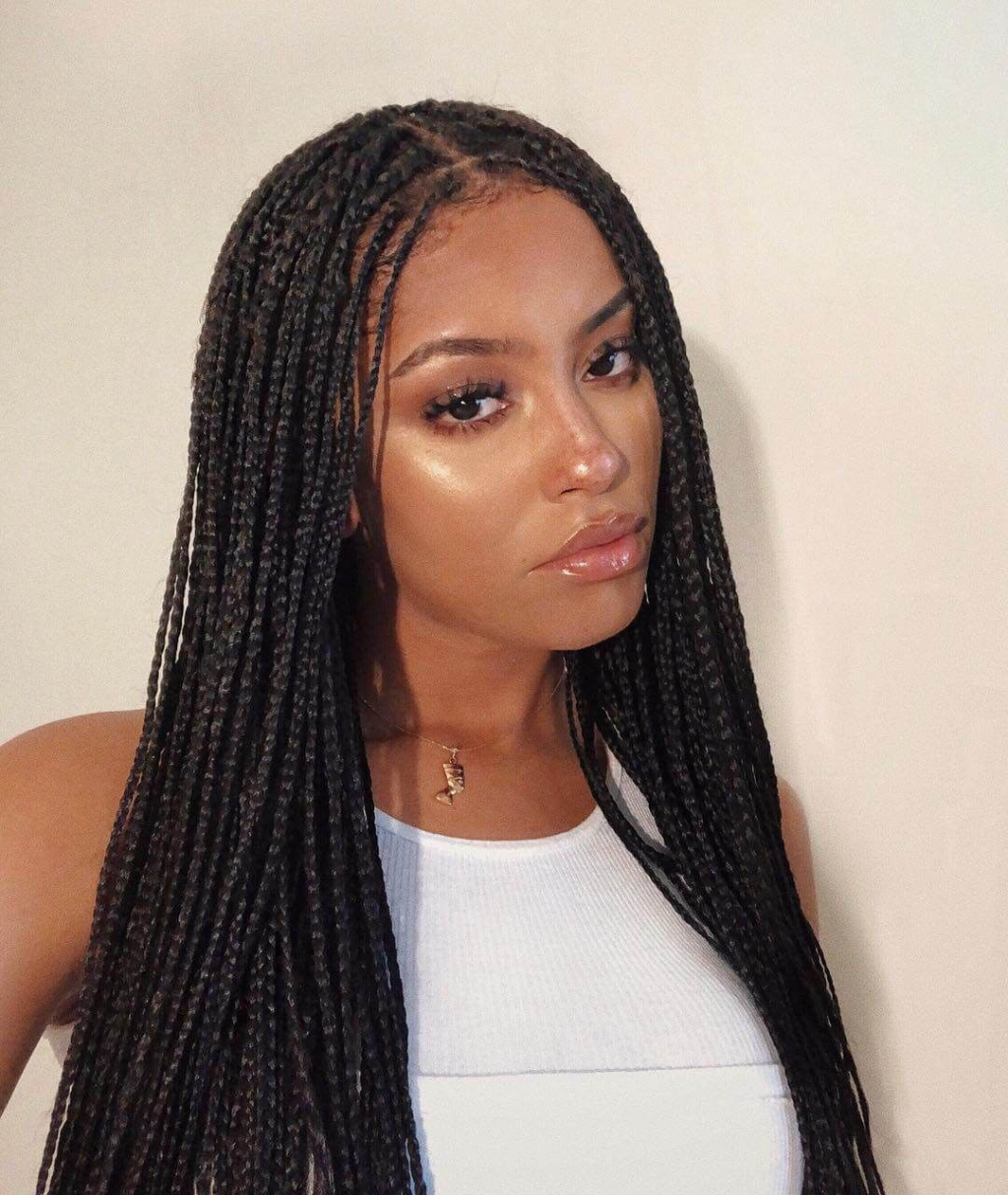Introduction
Overview of Knotless Braids
Knotless braids are a popular protective hairstyle that involves braiding hair without the traditional knot at the base. This technique is gentle on the scalp and results in a more natural look. Unlike traditional box braids, knotless braids start with your natural hair and the extension hair is gradually added as you braid. This method reduces tension and prevents breakage, making it an ideal choice for those looking to maintain healthy hair.
Importance and Popularity of Knotless Braids
Knotless braids have gained immense popularity due to their numerous benefits. They are less painful to install, put less stress on the scalp, and have a more seamless and natural appearance. Celebrities and influencers often showcase this style, further driving its popularity. Additionally, knotless braids offer great versatility, allowing for various styling options without compromising hair health.

Purpose of the Guide
This guide aims to provide a detailed, step-by-step process for achieving perfect knotless braids. Whether you are a beginner or someone looking to refine your braiding skills, this guide will offer valuable insights and tips to help you create beautiful, long-lasting knotless braids.
Preparation
Hair Preparation
Washing and Conditioning
Start with clean hair. Wash your hair thoroughly using a clarifying shampoo to remove any product buildup. Follow with a deep conditioner to ensure your hair is well-moisturized and manageable. Rinse the conditioner out thoroughly and apply a leave-in conditioner for added moisture.
Detangling and Drying
After washing and conditioning, gently detangle your hair using a wide-tooth comb or a detangling brush. Make sure to work through any knots or tangles carefully to avoid breakage. Once detangled, dry your hair completely. You can either air dry or use a blow dryer with a comb attachment to stretch your hair, making it easier to braid.
Tools and Materials Needed
Hair Extensions
Choose high-quality hair extensions that match your natural hair texture and desired length. Synthetic hair like Kanekalon is commonly used for braiding due to its lightweight and natural look.
Rat-tail Comb
A rat-tail comb is essential for parting and sectioning your hair precisely.
Hair Clips
Use hair clips to hold sections of hair in place while you braid.
Edge Control
Edge control gel helps to smooth and lay down your edges for a neat and polished look.
Hair Gel or Pomade
Hair gel or pomade is useful for keeping your natural hair sleek and blending it with the extensions.
Hair Scissors
Scissors are needed to trim any excess hair and clean up the ends of your braids.

Step-by-Step Guide
Sectioning the Hair
Parting the Hair
Begin by parting your hair into sections. Start from the back and work your way to the front. Use the rat-tail comb to create clean, straight parts. Secure each section with hair clips to keep them separated and organized.
Creating Even Sections
Ensure that each section is even in size for a uniform look. The size of the sections will determine the thickness of the braids. Smaller sections result in thinner braids, while larger sections create thicker braids.
Starting the Knotless Braids
Picking Up the Hair
Take a small section of hair from the first parted section. Divide this section into three equal parts and start a traditional braid using just your natural hair.
Adding Extensions
As you braid, gradually add small pieces of extension hair. Begin by placing the extension hair under the natural hair sections and continue braiding. Add more extension hair as you progress to achieve the desired braid length and thickness.
Braiding Technique
Maintain a consistent tension as you braid to ensure a neat and uniform look. Continue braiding until you reach the end of the natural hair, then braid the extension hair to the desired length.
Maintaining Consistency
Keeping Even Tension
It’s crucial to keep an even tension throughout the braiding process to avoid uneven braids and discomfort. Adjust your grip as needed to ensure the braids are neither too tight nor too loose.
Adding Hair Gradually
Gradually add small amounts of extension hair to maintain a natural transition from your scalp to the braid. This technique prevents the braids from appearing bulky at the roots.
Finishing the Braids
Securing the Ends
Once you reach the desired length, secure the ends of the braids with a small elastic band. Alternatively, you can dip the ends in hot water to seal them, which helps to prevent unraveling.
Trimming Flyaways
Use hair scissors to trim any flyaway hairs and create a polished finish. Be careful not to cut the main braid.
Aftercare
Maintaining Knotless Braids
Night Care
Protect your braids at night by wearing a satin or silk scarf or bonnet. This reduces friction and prevents frizz.
Scalp Care
Keep your scalp clean and moisturized. Use a light oil or braid spray to nourish your scalp and prevent dryness.
Moisturizing the Braids
Apply a leave-in conditioner or braid spray to keep your braids hydrated. This helps maintain their appearance and prevents them from becoming brittle.
Styling Tips
Versatile Styles
Knotless braids can be styled in various ways, including updos, ponytails, and buns. Experiment with different looks to find what suits you best.
Protective Styles
Knotless braids are a protective style that helps to shield your natural hair from damage. Ensure that any additional styling does not pull or strain your braids.

How Long Knotless Braids Last
Typical Duration
Knotless braids typically last 4 to 6 weeks with proper care. The duration can vary depending on your hair type and maintenance routine.
Signs It’s Time to Remove
When your braids start to look frizzy, or your hair grows out significantly, it’s time to remove them. Avoid leaving braids in for too long to prevent damage to your natural hair.
Benefits and Challenges
Benefits of Knotless Braids
Less Tension on Scalp
Knotless braids put less tension on the scalp, reducing the risk of headaches and hair breakage.
Natural Look
Knotless braids have a more natural appearance, blending seamlessly with your natural hair.
Versatility
These braids offer great versatility in styling and are suitable for various hair types and lengths.
Challenges of Knotless Braids
Time-Consuming
The installation process can be time-consuming, especially for beginners.
Requires Practice
Achieving a consistent and professional look requires practice and patience.
Conclusion
Summary of Key Points
Knotless braids are a popular protective hairstyle that offers numerous benefits, including reduced scalp tension, a natural look, and versatile styling options. While the process can be time-consuming and requires practice, the results are worth the effort.
Encouragement to Try Knotless Braids
Whether you’re new to braiding or looking to improve your technique, knotless braids are a great option to consider. With proper preparation, tools, and aftercare, you can achieve beautiful and long-lasting knotless braids.
FAQ
What are knotless braids?
Knotless braids are a type of protective hairstyle that starts with your natural hair and gradually incorporates extension hair, avoiding the traditional knot at the base.
How long do knotless braids take to install?
The installation time varies depending on the length and thickness of the braids, typically taking anywhere from 5 to 10 hours.
Are knotless braids better than traditional braids?
Many prefer knotless braids over traditional braids due to their reduced tension on the scalp and more natural appearance.
How do you maintain knotless braids?
Maintain knotless braids by keeping your scalp clean and moisturized, protecting your braids at night, and using braid spray or leave-in conditioner.
Can you wash knotless braids?
Yes, you can wash knotless braids. Use a diluted shampoo to gently cleanse your scalp and braids, then follow with a light conditioner.
How long do knotless braids last?
With proper care, knotless braids can last between 4 to 6 weeks.
Are knotless braids good for all hair types?
Yes, knotless braids are suitable for various hair types, including natural, relaxed, and transitioning hair.
What hair extensions are best for knotless braids?
High-quality synthetic hair extensions, such as Kanekalon, are ideal for knotless braids due to their lightweight and natural look.
How can I prevent frizz in knotless braids?
Prevent frizz by regularly moisturizing your braids, using a satin or silk scarf at night, and avoiding excessive manipulation.







